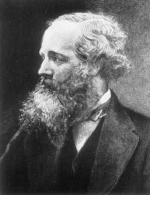James Clerk Maxwell
Physicist, b. 13 November 1831 (Edinburgh, Scotland), d. 5 November 1879 (Cambridge, England).
 Maxwell's father John Clerk was a lawyer in Edinburgh who had inherited an estate at Glenlair. Adopting the family name Maxwell was a legal requirement of the inheritance, and the family became known as the Maxwells. His mother died when James was 8 years old.
Maxwell's father John Clerk was a lawyer in Edinburgh who had inherited an estate at Glenlair. Adopting the family name Maxwell was a legal requirement of the inheritance, and the family became known as the Maxwells. His mother died when James was 8 years old.
Maxwell's career was characteristic of the first generations of professional scientists who had to seek employment at universities, but his father's inheritance gave him the option to retire from university teaching and follow his own interests. His most important work originated from a period where he lived at his family estate.
Reports from Maxwell's school days suggest that he was not so much interested in the school curriculum as he was stimulated into independent curiosity and investigation. He published his first scientific paper On the Description of Oval Curves at the age of 14. Two years later he entered the University of Edinburgh and published two more papers before moving to Cambridge University in 1850.
Although Maxwell's name is today linked with his famous equations, Maxwell was much more a physicist than a mathematician. His excellent intuitive insight into physical processes - his mathematics professor said that it seemed impossible for him to think wrongly on any physical subject - was not matched by comparable mathematical abilities; he more than once found important new formulas through flawed mathematical argument.
Having completed his Honours at Cambridge in 1854, Maxwell wanted to return to Scotland to be close to his father, whose health was failing. In 1856, only months after his father's death, he received an appointment as professor of natural philosophy at Marischal College of the University of Aberdeen. Four years later the university merged the college with its King's College and declared Maxwell redundant. An application to a vacancy at the University of Edinburgh was unsuccessful, and Maxwell had to accept an appointment at King's College in London.
During his time at King's College Maxwell worked on the physics of light and the hypothesis promoted at the time that white light is composed of three primary colours. By using three filters for the primary colours to produce three photos of the same object and combining them again through projection against a scree he effectively produced the first colour photographs. He also worked on the viscosity of gases and experimentally determined the statistical distribution of the energies of its molecules as a function of temperature, today known as the Maxwell-Boltzmann Law.
In 1865 Maxwell resigned from King's College and returned to his estate to work on electromagnetism. He attempted to describe Faraday's induction experiments in terms of waves. When he calculated the speed of the assumed waves in the dielectric medium he found that they travelled nearly with the speed of light and realized that light and electromagnetic phenomena are two expressions of the same process: He could, he said, "scarcely avoid the inference that light consists in the transverse undulations of the same medium which is the cause of electric and magnetic phenomena."
Maxwell's most important work Treatise on Electricity and Magnetism appeared in 1873. It was the synthesis of the work of several outstanding scientists and contained the set of equations - now known as Maxwell's equations - that laid the foundations for the theory of relativity, the development of radio and television, the invention of satellite remote sensing and other applications. Einstein later described Maxwell's work as "the most profound and the most fruitful that physics has experienced since the time of Newton."
In 1871 Maxwell returned to university teaching when he was appointed the foundation professor at the new Cavendish Laboratory of Cambridge University. He took ill in 1879 and returned to Glenlair, where he died a few months later of abdominal cancer, the same disease that had taken his mother at the same age of 48. He was buried quietly in the churchyard of a small village.
Reference
Domb, C. (1995) James Clerk Maxwell, Encyclopaedia Britannica 15th ed.
home
 Maxwell's father John Clerk was a lawyer in Edinburgh who had inherited an estate at Glenlair. Adopting the family name Maxwell was a legal requirement of the inheritance, and the family became known as the Maxwells. His mother died when James was 8 years old.
Maxwell's father John Clerk was a lawyer in Edinburgh who had inherited an estate at Glenlair. Adopting the family name Maxwell was a legal requirement of the inheritance, and the family became known as the Maxwells. His mother died when James was 8 years old.